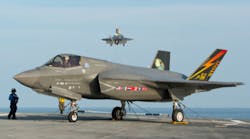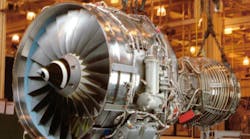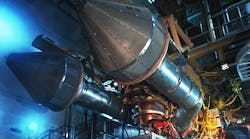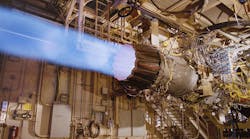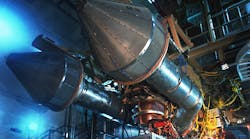The U.S. Department of Defense and Pratt & Whitney finalized a $508-million contract modification that authorizes the jet-engine builder to proceed with construction of the sixth series of F135 propulsion systems — the engines that power the F-35 Lightning II Joint Strike Fighter.
The so-called “low rate initial production” (LRIP) contract covers 38 total engines, and the new costs include program management, engineering support, production non-recurring effort, sustainment, and spare parts.
This contract modification pushes the total funding for the sixth series of engines to $1.1 billion.
The F-35 Lightning II is a single-engine jet with stealth capability used by the U.S. Air Force, U.S. Navy, U.S. Marine Corps, and Great Britain’s Royal Air Force, for ground attack, reconnaissance, and air defense missions. Lockheed Martin is the primary contractor for the jet-building program. The Defense Dept. stages its construction orders, to manage costs and to accommodate design changes and other supply and demand issue.
Pratt & Whitney builds the engines at its Middletown, Conn., complex, the site of several production programs for military and commercial contracts. To date, it has delivered 115 F-35 engines.
Deliveries of LRIP 6 engines will begin in the fourth quarter of this year.
The 38 engines in this contract include 36 engines in different variants for installation, and two of the conventional takeoff and landing (CTOL) version, for use as spares.
The U.S. Air Force will receive 18 CTOL engines in the contract. The U.S. Navy will receive seven carrier variant (CV) engines, and the U.S. Marine Corps will receive six short takeoff and vertical landing (STOVL) engines. The LRIP 6 contract also includes the three CTOL propulsion systems for the Italian defense forces, and two more for the Australian forces.
Milestone in Production, Value
In their joint statement on the contract modification, DoD and Pratt & Whitney claimed the agreement represents “a significant milestone” for the F-35 program, and reflects cost-reduction efforts by both the buyer and the supplier. The cost of the 32 common configuration engines (CTOL and CV variants) has been reduced by an estimated 2.5% compared to the fifth series, an order finalized last spring.
The prices for the six STOVL engines in LRIP 6 are reduced by roughly 9.6% compared to the previous LRIP 5 contract, they said.
"The engine price has been going down and that trend will continue," stated Lt. Gen. Chris Bogdan, F-35 program executive officer. "I've met with Pratt & Whitney's senior leaders and they are working closely with the supply chain to continue to bring down the cost to the government."
The LRIP 6 contract maintains fixed-price incentives Pratt & Whitney agreed to in LRIP 5, and company will continue to absorb all cost overruns. LRIP 6 adds the spare modules to these fixed-price incentive terms.
"Increasing the volume and production rate for F135 engines will be critical to realizing further cost savings for the propulsion system" according to Chris Flynn, vice president, Pratt & Whitney F135/F119 Engine Programs. “We remain focused on reducing costs, meeting our delivery schedule commitments, and increasing the tempo of contracting for LRIP 7 and LRIP 8.”
